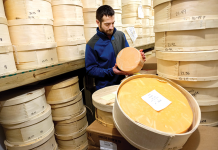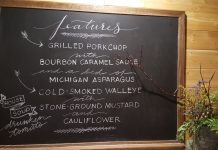THERE ARE MORE than a few places I’d like to recommend on the Michigan food scene, but my absolute favorites are culinary school restaurants. The food is beautifully prepared by students, painstakingly plated with tweezers under the watchful eye of a master chef. But the delicious part of dining at a student-staffed restaurant is witnessing the ever-so-earnest students blossom into chefs.
“They’re a bit tentative at first,” says Eric Gackenbach of Henry Ford College’s Fifty-One O One Restaurant in Dearborn. “Our regulars appreciate the hard work that they’re putting in and enjoy watching them progress, gain that confidence.”
“When the semester started, the students couldn’t properly hold a knife.”
— Dan Gendler
There, a Duet of Indiana Duckling cleverly marries a leg confit, pan-roasted breast, wild rice and orange demi-glace into a winning combination that was priced at $10.95.
At The Heritage at Grand Rapids Community College, the food is meant for admiring, with the menu divided into “small,” “large,” “green” and “finishing” dishes, all cooked into the prettiest plates imaginable.
The Smoked Shrimp Rillettes Crostini artfully arranged with skordilia (thick Greek garlic sauce), black olive vinaigrette, labneh (strained Lebanese yogurt,) beet salad and tomato fond ($5.95) shows the amount of thought that goes into every ingredient.

Shrimp crostini with skordilia, black olive vinaigrette, beet salad and cherry tomatoes
(Adapted from The Heritage at Grand Rapids Community College)
SKORDILIA
2 cups baked potato
1 cup ground almonds
6 garlic cloves, minced
1 tablespoon salt
¼ cup red wine vinegar
1 cup olive oil
1 cup mayonnaise
In a food processor, mix together potato, almonds, garlic, salt, vinegar, oil and mayonnaise. Whirl until thoroughly combined. Refrigerate until needed. Use a teaspoon to spread on both sides of crostini when plating.
BLACK OLIVE VINAIGRETTE
1 cup mayonnaise
½ cup sour cream
2 tablespoons Champagne vinegar
¼ cup apple cider vinegar
1 tablespoon Dijon mustard
1 tablespoon lemon juice
½ cup powdered (confectioner’s) sugar
2 cups pitted Kalamata olives
In a blender, combine all ingredients. Puree thoroughly on the highest speed. Place a portion of the recipe into a squeeze bottle for plating; chill.
BEET SALAD
Bunch purple beets. Trim leaves and keep about 2 inches of stalk intact, scrub well
Bunch golden beets. Trim leaves and keep about 2 inches of stalk intact, scrub well
½ cup Champagne vinegar
4 tablespoons powdered (confectioners’) sugar
½ tablespoon white seasoning (combine 3 tablespoons garlic powder/granules, 2 tablespoons salt, 2 tablespoons white pepper)
Keep purple and golden beets separate throughout cooking and plating to ensure the purple beets don’t turn the golden beets red. In a small saucepan, cover purple beets with cold water and add a pinch of salt. In a separate saucepan, cover golden beets with cold water and a pinch of salt. Boil until soft when pierced with a fork, about 20 minutes. Peel beets and medium dice. Store separately in nonreactive containers with lids.
Next, make dressing by combining Champagne vinegar, powdered sugar and white seasoning in a glass jar with a screw top. Shake until thoroughly mixed. In a small mixing bowl, combine half of the Champagne dressing with 1 cup red diced beets and chill. In a separate small mixing bowl, combine the remaining half of the Champagne dressing with 1 cup golden diced beets and chill.
CHERRY TOMATO SALAD
1 cup red cherry tomatoes. Halve lengthwise
1 cup orange cherry tomatoes. Halve lengthwise
3 tablespoons olive oil
1 tablespoons red wine vinegar
Kosher salt and freshly ground pepper to taste
In a small bowl, toss cherry tomatoes with olive oil, vinegar and seasoning; reserve.
CHIVE OIL
1 packed cup chive, blanched, refreshed and squeezed dry
1 packed cup cilantro
3 cups olive oil
1 tablespoon sugar
1 tablespoon salt
In a blender, combine all ingredients. Puree thoroughly on the highest speed. Place a portion of the recipe into a squeeze bottle for plating; chill.
GARLIC FLUTES
36 slices French bread, 2 inches long slight bias cut, ¼ inch thick
½ cup olive oil
3 garlic cloves, peeled
Brush the bread with the olive oil lightly. Grill the bread lightly on both sides, being careful not to burn the edges. Rub the garlic clove on to the surface of the bread. Reserve for dinner service. The bread should not be kept warm, to avoid it becoming too crisp.
SAUTEED SHRIMP
3 cloves garlic, crushed
Olive oil to sauté with
Fresh herbs: 2 sprigs thyme, 2 sprigs rosemary
2 pounds peeled and deveined shrimp
In a sauté pan, warm a drizzle of olive oil over medium heat. Add garlic cloves and fresh herbs. Add shrimp and cook for 3 to 4 minutes or until pink and firm. Do not overcook.
TO ASSEMBLE CROSTINI
On a plate, place a smear of the black vinaigrette to the side with an offset spatula. Spread 1 teaspoon skordilia on both sides of grilled garlic flutes (baguette slices). Arrange 2 skordilia garlic flutes per plate, and top with two to three shrimp. Decoratively scatter the beet and tomato salads around the garlic flutes. With chive oil in a squeeze bottle, place small dots in and around the salads. Makes 8 to 10 servings.
“Just think about it: When the semester started, the students couldn’t properly hold a knife,” says Dan Gendler, executive director of Secchia Institute of Culinary Education at GRCC. At semester’s end, students demonstrate knife acumen by slicing 50 perfect slices from a single tomato. “We’re after technical ability and real finesse.”
The restaurant’s second-floor setting is lovely, with picturesque floor-to-ceiling windows spilling light onto its white linen-covered tables. The Heritage’s cooking ticks off all the right boxes: intelligent, interesting with old-school glamour.
When the hot beverage cart rolled our way, we swooned at the spread of loose-leaf tea blends in delightful mason jars, including relaxed, silver needle and almond oolong. Orange rind, whipped cream, dark chocolate and the tiniest of silver spoons accompany Guatemalan and Honduran coffee varieties.

Come September, the Grand Rapids culinary school opens its brand-new brewery taproom, featuring 12 beers on tap. The culinary school’s brewing component will deliver a curriculum that prepares the students to sit for the first two levels of cicerone (beer expert) certification and will deliver the first Certified Beer Server certification within the course work, along with ServSafe alcohol and sanitation certifications. The students also will prepare for the initial Institute for Brewing and Distilling European certification — guaranteeing the students know beer like a sommelier knows wine.
“We’re the only program in the nation that will be college-owned, student-run, taking grain-to-glass and selling it to the public,” Gendler says. GRCC worked with the U.S. Treasury Department’s Alcohol and Tobacco Tax and Trade Bureau and Michigan Liquor Control Commission for a brewer’s license.
“Our students will be making beer in real time for our taproom,” Gendler says. “With Grand Rapids often earning the ‘Best Beer Town’ in national polls, it seems entirely fitting that the Secchia Institute (for Culinary Education) chartered the playbook on creating the first college-operated craft beer taproom.”
Les Cheneaux Culinary School in the Upper Peninsula is the newest culinary program in Michigan, its Restaurant at Les Cheneaux offering the prettiest setting. The boutique culinary school renovated the former Hessel Bay Inn to resemble the old iconic boathouses that dot the channels. The one-year program is designed for its 12 full-time students to complete an internship at the student-run, 55-seat restaurant that is open Memorial Day through Labor Day.
Launched in 2014, Les Cheneaux has a particular focus on Great Lakes cuisine. With the blessings of the 200 year-round residents, the culinary students have planted vegetable beds throughout the village.
“We definitely teach the students how to properly cook lake fish. That’s our culture up here, hunting and fishing,” says Chef Zach Schroeder. The Panko-crusted whitefish, adorned with beurre blanc and field greens, is made more special while watching the boats.
Back at Fifty-One O One in Dearborn, the student chef’s table-side preparation of banana flambé requires only humble ingredients but an expertise to put together.
Henry Ford College now offers a bachelor’s degree in culinary arts.
Where to dine
Restaurant at Les Cheneaux Culinary School: 186 S. Pickford Ave, Hessel. Open through Labor Day 11 a.m.-9 p.m. daily. (906) 484-4800, lcculinary.org
The Heritage at Grand Rapids Community College: Wisner-Bottrall Applied Technology Center at Fountain and Ransom streets, Grand Rapids. Parking is off Ransom. Reopens Sept. 7, with lunch 11:15 a.m.-12:45 p.m. and dinner 5:30-7 p.m. Tuesday through Friday. (616) 234-3700, opentable.com
Fifty-One O One Restaurant: Culinary Arts and Student Center (Building M), Henry Ford College, 5101 Evergreen Road, Dearborn. Reopens in early September, lunch 11:30 a.m.-1 p.m. Tuesday through Thursday and dinner 6-7:45 p.m. Wednesday and Thursday. (313) 206-5101
Award-winning journalist and author Jaye Beeler lives in Grand Rapids with her family.







Facebook Comments